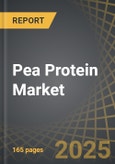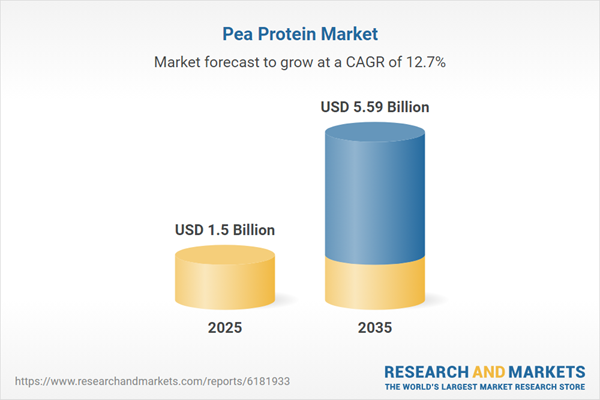PEA PROTEIN MARKET: GROWTH AND TRENDS
Pea protein is a high-quality, plant-derived protein sourced from yellow peas (Pisum sativum). It is commonly used as a nutritional supplement and ingredient in food due to its impressive nutritional content, functional attributes, and compatibility with various dietary preferences. Typically, pea protein consists of 80-85% protein by weight, making it an excellent protein source.Pea protein can be produced through either dry or wet methods, resulting in a range of products, including isolates, concentrates, and textured forms. The isolate is the most favored product due to its high level of refinement and protein concentration. In this context, the market for pea protein is expected to witness remarkable growth in the coming years, driven by a rising interest in vegan diets and plant-based protein options globally.
Notably, there has been a significant surge in the demand for plant-based protein over the past few years, creating fresh prospects for the pea protein market. Another important factor contributing to the benefits of pea protein is its nutritional benefits, which include an array of essential amino acids, vitamins, and minerals like iron, which supports overall well-being. Additionally, its hypoallergenic properties, ease of digestion, and suitability for vegans and vegetarians, along with its sustainability, boost its market demand.
Consequently, to capitalize on these opportunities, companies in the industry are increasing their production capabilities by investing in research and development to create new pea protein products with enhanced taste, texture, and nutritional profiles. Owing to the increasing demand for plant-based diets and the advantages of pea protein, coupled with advancements in technology, the pea protein market is expected to increase during the forecast period.
PEA PROTEIN MARKET: KEY SEGMENTS
Market Share by Type of Product
Based on type of product, the global pea protein market is segmented into concentrates, hydrolysates, isolates, and textured. According to our estimates, currently, isolates segment captures the majority share of the market. Pea protein isolate typically comprises around 85-90% protein, which makes it particularly attractive for nutritional supplements and protein-rich foods that appeal to consumers pursuing high-protein diets. As a result, it is commonly incorporated into nutritional supplements like meat alternatives, energy drinks, fruit blends, and baked goods. However, the concentrates segment is expected to grow at a relatively higher CAGR during the forecast period.Market Share by Type of Form
Based on type of form, the pea protein market is segmented into gas, liquid, and solid. According to our estimates, currently, solid form of the pea protein captures the majority of the market. This can be attributed to the rising demand for pea protein in powdered form, which offers a streamlined formulation process that allows for precise measurement and consistent distribution in food and beverage products. Additionally, its extended shelf-life, lighter weight, reduced volume, lower spoilage risk, and decreased transportation costs for both manufacturers and consumers further drive the growth of this segment.However, liquid forms of pea protein, such as those found in juices and energy drinks, is expected to grow at a relatively higher CAGR during the forecast period.
Market Share by Type of Source
Based on type of source, the pea protein market is segmented into chickpeas, lentils, yellow split peas, and others. According to our estimates, currently, yellow split peas segment captures the majority share of the market. Yellow split peas are a key factor in boosting market demand because they are high in protein, making them an excellent protein source.Additionally, these legumes are not only abundant in protein, but they also offer numerous nutritional advantages such as fiber, vitamins, and minerals, contributing to the increasing demand for plant-based protein options. However, chickpeas segment, is expected to grow at a relatively higher CAGR during the forecast period.
Market Share by Type of Processing Method
Based on type of processing method, the pea protein market is segmented into dry processing methods and wet processing methods. According to our estimates, currently, the dry processing segment captures the majority share of the market. Additionally, this segment is anticipated to experience a relatively higher growth rate during the forecast period.This can be attributed to the benefits offered by dry processing, which enables the creation of a diverse array of pea protein products, such as concentrates and isolates, with different protein levels and functionalities tailored to distinct applications and consumer needs.
Market Share by Area of Application
Based on area of application, the pea protein market is segmented into animal feed, bakery goods, beverages, dietary supplements, infant nutrition, meat substitutes, personal cosmetics, and others. According to our estimates, currently, bakery goods segment capture the majority share of the market. This can be attributed to the increasing demand for plant-based protein in the baking sector for creating items like protein brownies, cookies, superfood bites, diet truffles, and protein snacks.Further, the desire to improve nutritional value and addressing sustainability issues are additional factors that contribute to the rising demand for pea protein in the baking industry. However, the dietary supplements segment, is expected to grow at a relatively higher CAGR during the forecast period, due to heightened awareness and the adoption of fitness practices and healthy living, which boosts the need for protein-rich supplements.
Market Share by End User
Based on end user, the pea protein market is segmented into animal feed manufacturers, food processors, households, and others. According to our estimates, currently, food processors segment captures the majority share of the market. This can be attributed to the increasing demand for plant-based, allergen-free, and high-protein options, its adaptability, functional characteristics, and alignment with health and sustainability trends render it an essential ingredient across various food applications.Market Share by Company Size
Based on company size, the pea protein market is segmented into small, medium-sized enterprises (SMEs) and large enterprises. According to our estimates, currently, large size companies capture the majority share of the market. This can be attributed to their ample resources, economies of scale, and extensive global distribution networks. Additionally, their strategic partnerships and capability to meet regulatory standards enable them to maintain their dominant status in the international market.In contrast, SMEs are expected to experience a relatively higher CAGR during this forecast period. This can be attributed to their focus on innovation, targeting niche markets, and emphasizing sustainability. Furthermore, their local manufacturing, partnerships, and direct engagement with consumers broaden their market presence and assist in expanding their outreach.
Market Share by Type of Distribution
Based on type of distribution, the pea protein market is segmented into supermarkets / hypermarkets, specialty stores, online channels, pharmacies, and others. According to our estimates, currently, supermarket and hypermarket sector capture the majority share of the market. This can be attributed to the widespread availability of supermarkets, customer trust, greater product visibility, and a comprehensive shopping experience. In addition to market penetration, successful consumer engagement strategies are important for driving market growth.However, online retail channels are expected to experience a relatively higher CAGR during this forecast period, due to their convenience, detailed product information, competitive pricing, diverse options, and easy access.
Market Share by Geographical Regions
Based on geographical regions, the pea protein market is segmented into North America, Europe, Asia, Latin America, Middle East and North Africa, and the rest of the world. According to our estimates, currently, North America captures the majority share of the market. The increasing popularity of lifestyles such as veganism, vegetarianism, and flexitarianism significantly boosts the demand for plant-based protein sources like pea protein. Additionally, advancements in food technology and product innovation, a strong presence of established market players, heightened consumer awareness, and efficient distribution networks are significantly driving market growth in North America.However, market in Asia Pacific is expected to grow at a higher CAGR during the forecast period, due to its growing population and evolving dietary preferences. The rising demand for food and beverages in countries such as China and India, which has a vast consumer base, offers significant opportunities for the integration of pea protein into a wide range of products. Further, government efforts to promote sustainable farming practices and support the cultivation of peas as a protein-dense crop provide considerable prospects for pea protein producers in this region.
PEA PROTEIN MARKET: RESEARCH COVERAGE
The report on the pea protein market features insights on various sections, including:- Market Sizing and Opportunity Analysis: An in-depth analysis of the pea protein market, focusing on key market segments, including [A] type of product, [B] type of form, [C] type of source, [D] type of processing method, [E] type of application, [F] type of end user, [G] type of distribution, [H] company size, and [I] key geographical regions.
- Competitive Landscape: A comprehensive analysis of the companies engaged in the pea protein market, based on several relevant parameters, such as [A] year of establishment, [B] company size, [C] location of headquarters and [D] ownership structure.
- Company Profiles: Elaborate profiles of prominent players engaged in the pea protein market, providing details on [A] location of headquarters, [B] company size, [C] company mission, [D] company footprint, [E] management team, [F] contact details, [G] financial information, [H] operating business segments, [I] service / product portfolio, [J] moat analysis, [K] recent developments, and an informed future outlook.
- SWOT Analysis: An insightful SWOT framework, highlighting the strengths, weaknesses, opportunities and threats in the domain. Additionally, it provides Harvey ball analysis, highlighting the relative impact of each SWOT parameter.
- Value Chain Analysis: A comprehensive analysis of the value chain, providing information on the different phases and stakeholders involved in the pea protein market.
KEY QUESTIONS ANSWERED IN THIS REPORT
- How many companies are currently engaged in pea protein market?
- Which are the leading companies in this market?
- What factors are likely to influence the evolution of this market?
- What is the current and future market size?
- What is the CAGR of this market?
- How is the current and future market opportunity likely to be distributed across key market segments?
REASONS TO BUY THIS REPORT
- The report provides a comprehensive market analysis, offering detailed revenue projections of the overall market and its specific sub-segments. This information is valuable to both established market leaders and emerging entrants.
- Stakeholders can leverage the report to gain a deeper understanding of the competitive dynamics within the market. By analyzing the competitive landscape, businesses can make informed decisions to optimize their market positioning and develop effective go-to-market strategies.
- The report offers stakeholders a comprehensive overview of the market, including key drivers, barriers, opportunities, and challenges. This information empowers stakeholders to stay abreast of market trends and make data-driven decisions to capitalize on growth prospects.
ADDITIONAL BENEFITS
- Complimentary Excel Data Packs for all analytical modules in the report
- 15% free content customization
- Detailed report walkthrough session with the research team
- Free report update available for reports older than 6 months
Table of Contents
Companies Mentioned (Partial List)
A selection of companies mentioned in this report includes, but is not limited to:
- Axiom Foods
- Burcon Nutrascience
- Cargill
- Cosucra Groupe Warcoing
- DuPont
- Emsland
- Fenchem
- Glanbia
- Ingredion
- Martin & Pleasance
- Nutri-Pea
- Roquette Freres
- Shandong Jianyuan Group
- Sotexpro
- The Green Labs
- The Scoular Company
- Yantai Shuangta Food
Methodology

LOADING...
Table Information
| Report Attribute | Details |
|---|---|
| No. of Pages | 165 |
| Published | October 2025 |
| Forecast Period | 2025 - 2035 |
| Estimated Market Value ( USD | $ 1.5 Billion |
| Forecasted Market Value ( USD | $ 5.59 Billion |
| Compound Annual Growth Rate | 12.7% |
| Regions Covered | Global |









